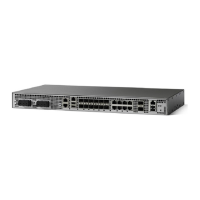CHAPTER 4
MPLS LSP Ping, Traceroute, and AToM VCCV
As Multiprotocol Label Switching (MPLS) deployments increase and the traffic types they carry increase,
the ability of service providers to monitor label switched paths (LSPs) and quickly isolate MPLS forwarding
problems is critical to their ability to offer services. The MPLS LSP Ping, Traceroute, and AToM VCCV
feature helps them mitigate these challenges.
The MPLS LSP Ping, Traceroute, and AToM VCCV feature can detect when an LSP fails to deliver user
traffic.
•
You can use MPLS LSP Ping to test LSP connectivity for IPv4 Label Distribution Protocol (LDP)
prefixes, traffic engineering (TE) Forwarding Equivalence Classes (FECs), and AToM FECs.
•
You can use MPLS LSP Traceroute to trace the LSPs for IPv4 LDP prefixes and TE tunnel FECs.
•
Any Transport over MPLS Virtual Circuit Connection Verification (AToM VCCV) allows you to use
MPLS LSP Ping to test the pseudowire (PW) section of an AToM virtual circuit (VC).
Internet Control Message Protocol (ICMP) ping and trace are often used to help diagnose the root cause
when a forwarding failure occurs. The MPLS LSP Ping, Traceroute, and AToM VCCV feature extends this
diagnostic and troubleshooting ability to the MPLS network and aids in the identification of inconsistencies
between the IP and MPLS forwarding tables, inconsistencies in the MPLS control and data plane, and
problems with the reply path.
The MPLS LSP Ping, Traceroute, and AToM VCCV feature uses MPLS echo request and reply packets to
test LSPs. The Cisco implementation of MPLS echo request and echo reply are based on the Internet
Engineering Task Force (IETF) Internet-Draft Detecting MPLS Data Plane Failures.
•
Prerequisites for MPLS LSP Ping, Traceroute, and AToM VCCV, page 63
•
Restrictions for MPLS LSP Ping, Traceroute, and AToM VCCV, page 64
•
Information About MPLS LSP Ping, Traceroute, and AToM VCCV, page 64
Prerequisites for MPLS LSP Ping, Traceroute, and AToM VCCV
Before you use the MPLS LSP Ping, Traceroute, and AToM VCCV feature, you should:
•
Determine the baseline behavior of your Multiprotocol Label Switching (MPLS) network. For example:
•
What is the expected MPLS experimental (EXP) treatment?
MPLS Basic Configuration Guide, Cisco IOS XE Everest 16.5.1 (Cisco ASR 900 Series)
63

